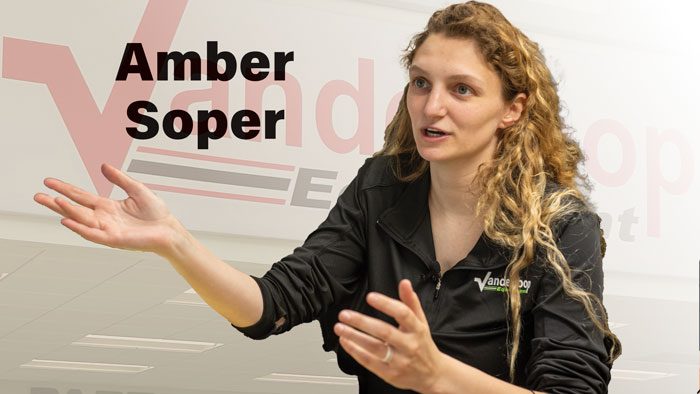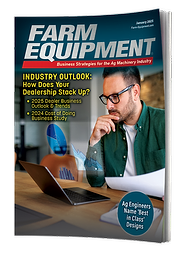Amber Soper’s official title may be parts lead for Vanderloop Equipment’s (VE) store in Lena, Wis., but if you ask her what her job is, it’s simple: to “make the customer happy.”
Aside from administrative tasks like closing out invoices and handling monthly returns, claims and shipments, her primary role is to interact with customers and get them what they need. An average day involves answering phone calls, providing over-the-counter parts, scheduling in-shop work or service calls, putting in daily orders, and tending to customers’ needs. She also works hand-in-hand with store lead Doug Neta.
“It’s nice to have two people trained in the same things, so when one’s busy, the other can handle it,” she says.
Soper gives Neta a lot of credit for helping her learn the role on-the-job. Joining VE was a big pivot for Soper, who started her career working as an agronomist after first earning her associate degree in ag business. She started doing scouting and making variable-rate maps. But after a couple of years of working long days — analyzing about 3,000-5,000 acres per day during the cropping season — she realized she was ready for a change.
Amber Soper
Years with Organization: 5
Role: “Every day is different. I could be writing quotes, working with the technician for in-shop work, pulling parts for them, and in the same breath answering phone calls and working with customers. I like that I get to bounce around and do different things every day.”
Quotable: “I like when a customer comes in and you get to see their face. It’s a lot easier to build a relationship with a customer when you finally get to meet them in person after you’ve talked on the phone with them several times throughout the year.”
Speaking the Language
While working in the parts department is physically less demanding than field work, mentally Soper says it’s a little more strenuous because she’s “trying to problem-solve, helping figure out what the customer’s needs are when I’m not physically there to look at it.”
That was the biggest learning curve Soper faced in her role at VE. She never had to speak to customers much in her previous job, especially over the phone, so she relied on Neta to learn how to relate and talk to them.
“You must learn the language of every customer and the language of your technicians,” she says. “There’s a lot that goes into just learning how people explain things.”
Modern technology helps break down that language barrier. Soper can ask customers to send photos of the parts they need and she can do the same to confirm they’re getting what they want.
“Sometimes it helps to send them a picture of a breakdown in the parts book and they say, ‘Yup, I need numbers 7, 8, 9,’” she says. “It makes the process a lot simpler.”
It also helps when she has slower days to watch the technicians work on equipment and physically see the pieces that she normally wouldn’t see.
“You can then see how they work and you can better work with the customer when they call you for parts.”
Measuring Success by Customer Satisfaction
Customer satisfaction is how Soper defines success.
“How I measure success is if you’re able to help the customer that day when they call and need the part,” she says.
A lot of that requires good inventory management and making sure VE has the right parts in stock when customers need them, which is based on sales history. For example, if a part that has been sitting for 6 months finally gets sold, and the next day another farmer needs that same part, she doesn’t measure the latter as unsuccessful because the sales history didn’t exist to indicate VE needed more of that part in stock.
“When it’s going to rain, the whole mood switches. That’s when you know it’s ‘go time.’ We need to have the right parts or we need to have them the next day…”
In those cases, she determines success based on how quickly she can get that part to the customer without additional charges and fees. An advantage to having multiple locations is that if Soper doesn’t have a part in stock, she can check with their other locations. If one exists and it’s a dire need — like it’s going to rain and the customer needs it ASAP — they’ll meet halfway between the stores, or if someone is available, run it from one store to the other.
If it’s not in stock at any location, then she’ll order it. Their system syncs with the manufacturers’ systems so all she has to do is enter the part and shipment priority based on when the customer needs it, and then she receives a confirmation number so she knows the order is in progress.
Being an AGCO dealer also means that Soper deals with the challenge of hunting down parts from legacy brands and seeing if a part is still available, especially for older AGCO and Massey equipment. Often that requires looking into the sister companies that AGCO partners with for aftermarket items. It’s a big win when she can find a part for older equipment.
“The customers are tickled pink when I can get a part to save their 190 Allis and keep them moving,” she says.
Managing Inventory
VE’s inventory is managed through a computer system. As long as Soper has a parts number, she can look it up and see how many they have in stock and exactly where the part is located in their stockroom.
The stockroom in Lena is organized so that most of their in-demand parts are kept in close distance on the floor, while an upstairs area serves as an overflow for larger, lighter parts that either don’t fit downstairs or don’t move as often. They also try to seasonally rotate in parts during the cutting season so they’re easier to access.
If the system says a part is in stock, Soper says 9 times out of 10 that’s accurate.
“We are humans,” Soper says. “Sometimes things get screwed up in the system or you’re moving too fast and forget to put something on a ticket.”
Overcoming Stereotypes & Building Credibility
One challenge Amber Soper has learned to navigate is being doubted on her abilities by customers because she’s a woman.
“They don’t typically think that I can do this job,” she says. “Whenever I answer the phone, I get a lot of, ‘Can I talk with parts please?’ I say, ‘This is parts,’ and then they’re like, ‘Are you sure?’”
She recalls one customer who had a 1950s tractor and didn’t think she’d be able to track down parts for him. When he came in to pick the parts up, he confessed that when he first saw her, he didn’t think she was going to know what she was talking about and felt bad about his presumptions.
But Soper laughed with the customer about it. She doesn’t let those assumptions bother her.
“I just do the job. You show up, you do the job. It makes me chuckle, really,” she says. “Getting into what today’s technology is, anyone has to learn it. It’s not something you just wake up and know every piece of a machine it takes. So, I don’t let it get to me because we could hire a male in my position tomorrow and they could be the exact same as how I was when I first started.”
That’s why VE makes it a priority to do inventory before the busy season and before the big winter stock orders, to make sure those issues are corrected and their inventory count is accurate.
One of the challenges of managing inventory is making sure old items goes out before new ones do, and keeping track of the old inventory that’s in stock.
“A lot of times the manufacturers will sub numbers and you won’t realize it,” she says. “You could have an old number in stock for a few years.”
Because everything is looked up by serial number, new parts books will change the serial number for a part slightly because they changed the manufacturer for it or some minor aspect of it. But functionality-wise, it’s the same part as the ones with older serial numbers, so Soper tries to make sure those older ones are sold first. VE now has a system in place where it can backtrack numbers. “If you kept putting new numbers in, you would fill it up while still keeping old inventory,” Soper says.
Crunch Time Experience
Like many jobs in ag, it can be a challenge to plan ahead. But Soper makes sure she gets parts orders in on time to avoid additional charges, and she helps plan service calls and in-shop appointments. She’s also mindful of the time crunches farmers face, and ensures that the dealership is prepared for them.
“When it’s going to rain, the whole mood switches,” she says. “If they’re calling for rain within a few days or a week out and everybody wants to cut and chop 4 days prior, that’s when you know it’s ‘go time.’ We need to have the right parts or we need to have them the next day.”
While Soper didn’t grow up on a farm, she started working for local farms from her early teens through college. She has first-hand experience of needing to cut, rake and bale hay before a rain, which prepared her for the urgency and pressure she faces in her role.
“Dealing with these customers is a lot different than if you just worked in a regular retail store,” she says. “Nobody cares when they go get their groceries, what the weather is like. But these guys, they’re losing money every minute they’re down. So it helped me be much more prepared for that.”
Building Customer Relationships
As work loads grow, Soper is taking on more responsibilities. She’s learning more about the service side of the business so anyone joining the team understands the jobs Neta currently handles.
One area she is looking to improve is the technical side, so she can assist customers over the phone the way Neta does and avoid having to send a tech out to handle a simple fix.
“Doug’s worked a lot more hands-on with the machines, so he can go sit out in a tractor and walk through things with customers,” she says.
“I hope to grasp that so I can help them if he’s busy or all of our guys out on service calls. It helps the customer to know they have people here capable of doing that simple fix.”
Building relationships with customers is one of her favorite parts of this job, especially when they come in and she gets to meet them face-to-face.
“It’s a lot easier to build a relationship with a customer when you finally get to see them after you’ve talked on the phone with them for almost a year,” she says. “You just know you secure that relationship a little bit more with them.”
Dealership Minds: Vanderloop Equipment Introduction
Dealership Minds: CFO & Co-Owner: Cashflow Rules The Day
Dealership Minds: Sales Manager & Co-Owner: Guiding Sales, Finding New Markets
Dealership Minds: Technology Sales & Co-Owner: Learning from the Past to Move Forward
Dealership Minds: Lena Store Lead: The Power of Personalization
Dealership Minds: Parts Department Lead: Customer Communication Key to Success in Parts
Dealership Minds: Beaver Dam Sales: Techs are ‘Game-Changer’ in New Wholegoods Sales
Dealership Minds: Service Department Manager: A True Passion for Customer Service
Dealership Minds: Service Department Lead: Service: Beyond Just Repairs
Dealership Minds: Parts Lead: Parts Department Brings New Challenges Every Day
Dealership Minds: Brillion Sales Reps: Building Relationships Beyond the Sale







